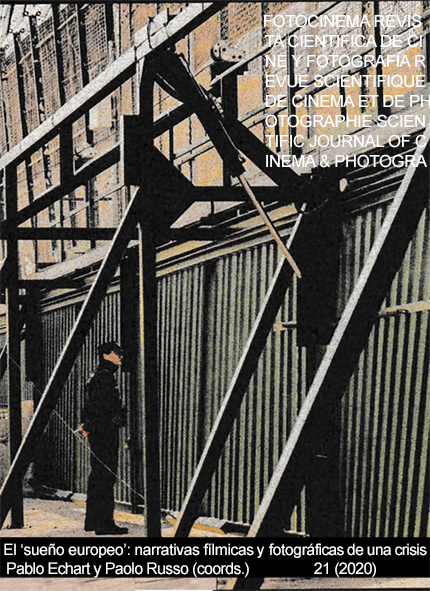Pablo Trapero’s poetics: impotence, cathabasis and corrosion of the law
DOI:
https://doi.org/10.24310/Fotocinema.2020.vi21.10015Keywords:
Argentine cinema, Trapero, Pablo, Authors, New Argentine Cinema, Film analysisAbstract
The aim of this article is to analyze some features of the poetics of Pablo Trapero, one of the most relevant and prolific directors of contemporary Argentine cinema. For this purpose, we have selected four films –El bonaerense (2002), Lion’s Den (2008), Carancho (2010) and The Clan (2015)– that are representative of different stages of his filmography. The study appeals to an authorial perspective, as well as a sociological approach of the films. The analysis of Trapero’s poetics is presented according to three axes: the construction of the characters, the figuration of family, and the emergence of a social outlook on Argentina post-crisis of 2001, marked by the corrosion of the law and the normalization of transgression. An authorial perspective contributes to the understanding of the so-called New Argentine Cinema and its industrial evolution: a phenomenon in which Trapero has played a fundamental role.
Downloads
Metrics
References
Aguilar, G. (2015). Más allá del pueblo. Imágenes, indicios y políticas del cine. Buenos Aires: Fondo de Cultura Económica.
Bajtín, M. (2008). Estética de la creación verbal. Buenos Aires: Siglo XXI.
Barthes, R. (2009). El susurro del lenguaje. Barcelona: Paidós.
Bauman, Z. (2010). Mundo consumo. Ética del individuo en la aldea global. Buenos Aires: Paidós.
Bazin, A. (2003). “De la política de los autores”. En Baecque, A. (comp.) La política de los autores. Manifiestos de una generación de cinéfilos. Barcelona: Paidós.
Beck, U. (1998). La sociedad del riesgo. Hacia una nueva modernidad. Barcelona: Paidós.
Bonitzer, P. (2007). El campo ciego. Ensayos sobre el realismo en el cine. Buenos Aires: Santiago Arcos.
Burke, Sean (1992). The Death and Return of the Author: Criticism and Subjectivity in Barthes, Foucault and Derrida. Edimburgo: Edinburgh University Press.
Deleuze, G. y Guattari, F. (1989). Mil mesetas. Capitalismo y esquizofrenia. Valencia: Pre-Textos.
Dieleke, E. (2012). “‘Lo real’ en suspenso: narrativas excepcionales de la Argentina reciente”. En Cuadernos de Literatura, Nº 32, julio-diciembre, pp. 155-185.
España, C. y Manetti, R. (1999). “El cine argentino, una estética comunicacional: de la fractura a la síntesis”. En Burucúa, J. E. (dir.). Nueva Historia Argentina. Arte, sociedad y política. Buenos Aires: Sudamericana.
Hortiguera, H. (2012). “Después de la globalización, la destrucción de lo social en dos filmes argentinos: Las viudas de los jueves y Carancho”. En Letras Hispanas, vol. 8.1, primavera, pp. 112-127.
Miccio, J. (2015). “De regreso: El clan”. En Hacerse la Crítica. En línea: https://www.hacerselacritica.com/de-regreso-el-clan-por-jose-miccio/
Mongin, O. (1999). Violencia y cine contemporáneo. Ensayo sobre ética e imagen. Barcelona: Paidós.
Musaluppi, H. (2016). “Tensiones. (Veinticinco años de Nuevo Cine Argentino)”. En Revista de Cine, Nº 3, pp. 99-107, Universidad del Cine.
Paulinelli, M. (coord.) (2005). Poéticas en el cine argentino. 1995-2005. Córdoba: Comunicarte.
Porta Fouz, J. (2007). “Genealogías: sobre críticos y personajes argentinos”. En El Amante, Nº 181, junio. En línea: www.otroscines.com/nota?idnota=331
Prividera, N. (2016). El país del cine. Para una historia política del nuevo cine argentino. Córdoba: Los Ríos.
Prividera, N. (2018). “Un muchacho como yo. A propósito de El ángel”. En Con los ojos abiertos, 21/08/2018. En línea: www.conlosojosabiertos.com/inconformista-02-la-colulmna-nicolas-prividera-muchacho-proposito-angel/
Turquet, M. y Pérez Rial, A. (2009). “Figuraciones de un espacio con historia. La mesa y su inserción en el relato del cotidiano familiar en el cine argentino de 1995-2005”. En Figuraciones, Nº 6, diciembre. En línea: http://revistafiguraciones.com.ar/numeroactual/articulo.php?ida=137&idn=6&arch
Verardi, M. (2009). “El Nuevo Cine Argentino: claves de lectura de una época”. En Amatriain, I. (coord.): Una década de nuevo cine argentino (1995-2005). Industria, crítica, formación, estéticas, pp. 171-189. Buenos Aires: CICCUS.
Verardi, M. (2010). Nuevo cine argentino (1998-2008): formas de una época. Tesis doctoral, Facultad de Filosofía y Letras, Universidad de Buenos Aires.
Downloads
Published
How to Cite
Issue
Section
License
All contents published in Fotocinema Revista científica de cine y fotografía are protected under the Creative Commons Attribution-NonCommercial-ShareAlike 4.0 International (CC BY-NC-SA 4.0) license. All about this license is available in the following link: <http://creativecommons.org/licenses/by-nc-sa/4.0>
Users can copy, use, redistribute, share and exhibit publicly as long as:
- The original source and authorship of the material are cited (Journal, Publisher and URL of the work).
- It is not used for comercial purposes.
- The existence of the license and its especifications are mentioned.
There are two sets of authors’ rights: moral and property rights. Moral rights are perpetual prerogatives, unrenounceable, not-transferable, unalienable, imprescriptible and inembargable. According to authors’ rights legislation, Fotocinema. Revista científica de cine y fotografía recognizes and respects authors moral rights, as well as the ownership of property rights, which will be transferred to University of Malaga in open access. The property rights are referred to the benefits that are gained by the use or the dissemination of works. Fotocinema. Revista científica de cine y fotografía is published in an open access form and it is exclusively licenced by any means for doing or authorising distribution, dissemination, reproduction, , adaptation, translation or arrangement of works.
Authors are responsable for obtaining the necessary permission to use copyrighted images.













13.png)




